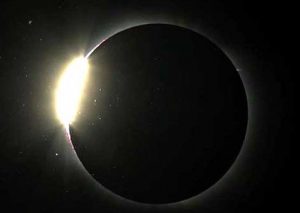 Washington, Feb 15: Ever witnessed a total solar eclipse? Here’s a chance for all those space lovers. Come March 8, 2016, the moon will cast its shadow as it is all set to pass in front of the sun. Parts of Southeast Asia will witness a total solar eclipse lasting for over a minute in every location on its path, revealed astronomers from NASA. Eclipses can be viewed using a solar-filtered telescope, eclipse glasses or a pinhole projector.
Washington, Feb 15: Ever witnessed a total solar eclipse? Here’s a chance for all those space lovers. Come March 8, 2016, the moon will cast its shadow as it is all set to pass in front of the sun. Parts of Southeast Asia will witness a total solar eclipse lasting for over a minute in every location on its path, revealed astronomers from NASA. Eclipses can be viewed using a solar-filtered telescope, eclipse glasses or a pinhole projector.
As the moon passes precisely between the sun and Earth – a relatively rare occurrence that happens only about once a year because of the fact that the moon and the sun do not orbit in the exact same plane – it will block the sun’s bright face, revealing the tenuous and comparatively faint solar atmosphere, the corona, they explained.
“The moon blocks the light of the sun’s surface very, very precisely you can see all the way down to the roots of the corona, where the atmosphere meets the sun’s surface,” said Sarah Jaeggli, a space scientist at NASA’s Goddard Space Flight Center in Maryland, US.
People along the path of totality – which is over 8,800 miles long, but only 97 miles wide at the widest point – will have the opportunity to see the solar corona only while the sun’s face is totally covered by the moon, while people outside this path will see varying degrees of a partial eclipse.
Totality will last for anywhere from one and a half to just over four minutes at each location, though more than three hours will pass between the time the westernmost location sees the eclipse begin and when the easternmost location sees the eclipse end, the scientists said.
A solar eclipse occurs when the moon’s shadow falls on Earth. The shadow comprises two concentric cones called the umbra and the penumbra. Within the smaller, central umbra, the sun is completely blocked by the moon, and anyone inside the umbra sees a total eclipse. People in the outer cone, the penumbra, will see only a partial solar eclipse.
The total solar eclipse of 1860 gave astronomers their first recorded glimpse of a coronal mass ejection, a cloud of solar material expelled from the sun at millions of miles per hour.
The study into coronal mass ejections reveals how they can affect near-Earth space, where disturbances in Earth’s magnetic field can sometimes impact radio communications, onboard satellite electronics and GPS. (IANS)
